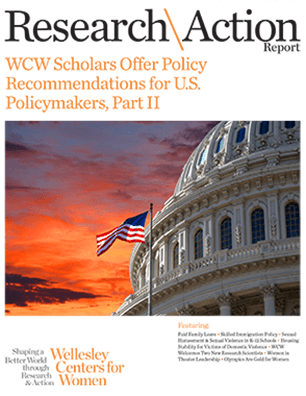Out-of-School Time Programming & Quality
Linda Charmaraman, Ph.D., Allison Tracy, Ph.D., Ineke Ceder, and Amanda Richer authored “Measuring Program Quality: Evidence of the scientific validity of the Assessment of Program Practices Tool (APT),” which will be published in an upcoming issue of Afterschool Matters. Funded by the William T. Grant Foundation and Virginia B. Toulmin Foundation in two phases, they describe APT’s strengths as an evaluation and program quality measure for out-of-school (OST) programs, a tool that is critical for program directors and policymakers who need to identify where to improve and how to support those improvements within OST programs. In addition, the online, video-based training developed in the second phase to increase reliability of APT raters showed promise, such that the most high priority APT quality areas were found to be the most improved (i.e., most accurate) scores post training.
Georgia Hall, Ph.D. contributed two papers that will be published in the SAGE Encyclopedia of Out-of-School Learning, edited by Kylie Peppler, Indiana University (forthcoming). “Summer Learning” focuses on out-of-school time (OST) programs where children and youth have the opportunity to build supportive relationships, test out new skills, gain valuable peer relationship experiences, and build social and emotional learning skills while supporting children’s wellness and continued learning while school is not in session. “Program Development, Implementation, and Evaluation” examines components of OST programs such as staffing, leadership, communication, planning, physical and financial resources, family and school relations, and programming, which can vary in quality but collectively contribute to the delivery of experiences to children and youth. They should be well run and organized with a central focus on promoting the healthy and positive development of children and youth.
“Credentialing for Youth Work: Expanding Our Thinking,” by Elizabeth Starr, M.Ed. and Ellen Gannett, M.Ed. is included in The Changing Landscape of Youth Work: Theory and Practice for an Evolving Field (Editors: Kristen M. Pozzoboni, San Francisco State University, and Ben Kirshner, University of Colorado Boulder). The book compiles and publicizes the best current thinking about training and professional development for youth workers. This volume is part of the series, Adolescence and Education (Series Editor: Ben Kirshner, University of Colorado Boulder), published by Information Age Publishing.
Depression Prevention
Tracy Gladstone, Ph.D. co-authored “Development and evaluation of a web-based clinician training program for a family-focused depression preventive intervention,” (Martin, J., Gladstone, T., Diehl, A., & Beardslee, W. 2016) included in the Journal of Technology in Human Services (Volume 34, 2016–Issue 3). This study evaluated the acceptability, feasibility, and satisfaction associated with a newly developed online clinician training program for the Family Talk preventive intervention, both alone and together with a redesigned, shortened, face-to-face component. Fifty-eight predominately in-home therapy clinicians participated in the study.

Results indicated that clinician participants found the online training to be enjoyable and comprehensive, and they reported that the most beneficial training package involved the combination of web-based and in-person training. This combined training could efficiently cover necessary didactic material online while also delivering important clinical skill practice and in-person discussion. Exceptions, limitations, and important future research questions are discussed.
Labor Markets
Sari Pekkala Kerr, Ph.D. co-authored “Global Talent Flows” with W.R. Kerr, C. Ozden and C. Parsons, included in the Journal of Economic Perspectives (forthcoming). This review considers recent research regarding high-skilled migration. The researchers adopt a data-driven perspective, bringing together and describing several ongoing research streams that range from the construction of global migration databases, to the legal codification of national policies regarding high-skilled migration, to the analysis of patent data regarding cross-border inventor movements. A common theme throughout this research is the importance of agglomeration economies for explaining highskilled migration. We highlight some key recent findings and outline major gaps that we hope will be tackled soon. A related article was published as National Bureau of Economic Research (NBER) Working Paper No. 22715 in October.

Kerr also co-authored “Weathering the Great Recession: Variation in Employment Responses by Establishments and Countries” with E. Barth, J. Davis and R. Freeman for inclusion in Russell Sage Foundation Journal (forthcoming). This paper was published as NBER Working Paper 22432. This article finds that U.S. employment changed differently relative to output in the Great Recession and recovery than in most other advanced countries or in the U.S. in earlier recessions. Instead of hoarding labor, U.S. firms reduced employment proportionately more than output in the Great Recession, with establishments that survived the downturn contracting jobs massively. Diverging from the aggregate pattern, U.S. manufacturers reduced employment less than output while the elasticity of employment to gross output varied widely among establishments. In the recovery, growth of employment was dominated by job creation in new establishments. The variegated responses of employment to output challenges extant models of how enterprises adjust employment over the business cycle.
Kerr co-wrote “Within and Between Firm Trends in Job Polarization: Role of Globalization and Technology” with Terhi Maczulskij and Mika Maliranta, recently published by the Research Institute of the Finnish Economy as ETLA Working Paper 41. This article analyzes occupational polarization within and across firms using comprehensive matched employer-employee panel data from Finland. The occupational distribution in Finland has been polarizing over the last few decades, with mid-level production and clerical jobs eroding while low-skill service occupations and highskill specialist occupations gain share. We find that the phenomenon is taking place within existing firms, as well as due to firm entry and exit. Service jobs are increasing through the entry-exit dynamics, but also via establishment level restructuring among continuing firms. Routine jobs, including mid-level plant operating jobs, are being destroyed both among continuing firms and at the entry-exit margin. The share of high-level occupations increases largely within continuing firms. Within the continuing firms the job polarization appears to be related to the trade of goods and services, as well as the outsourcing of tasks. Firms with high R&D expenditures and information and communications technology use are more prone to lay off process and production workers.
Justice and Gender-Based Violence
“It All Just Piles Up: Challenges to Victim Credibility Accumulate to Influence Sexual Assault Case Processing,” by Melissa Morabito, Ph.D., April Pattavina, Ph.D., and Linda M. Williams, Ph.D. is included in a recent issue of Journal of Interpersonal Violence. The underreporting of sexual assault is well known to researchers, practitioners, and victims. When victims do report, their complaints are unlikely to end in arrest or prosecution. Existing research on police discretion suggests that the police decision to arrest for sexual assault offenses can be influenced by a variety of legal and extra-legal factors particularly challenges to victim credibility. Although extant literature examines the effects of individual behaviors on police outcomes, less is known about how the accumulation of these behaviors, attributions, and characteristics affects police decision making. Using data collected from the Los Angeles Police Department and Sheriff’s Department, the researchers examine one police decision point—the arrest—to fill this gap in the literature. They examine the extent to which the effects of potential challenges to victim credibility, based on victim characteristics and behaviors, influence the arrest decision, and next, how these predictors vary across circumstances. Specifically, the team examines how factors that challenge victim credibility affect the likelihood of arrest in sexual assault cases where the victim and offender are strangers, acquaintances, and intimate partners.

“Active representation and police response to sexual assault complaints,” by Morabito, Pattavina, and Williams, is included in a recent issue of Journal of Crime and Justice. Policing has long been a profession dominated by white males. Yet, the organizational literature suggests that diverse public sector organizations are essential to a well-functioning democracy. Representative bureaucracy theory is the idea that public agencies should mirror the society in which it functions in order to best meet the needs of its citizens. There are three necessary conditions in order for representative bureaucracy theory to be applicable to a problem. First, bureaucrats must have discretion in decision-making. Next, bureaucrats must exercise discretion in a policy area that has important implications for the group they represent. Finally, bureaucrats must be directly associated with the decisions they make. Given that police work requires extraordinary discretion, representation holds great importance for police organizations. There has, however, been scant literature examining the interaction between representation, organizational characteristics of police agencies, and situational characteristics of sexual assault incidents. This paper builds upon previous research regarding the effect of diversity on public safety outcomes. A national sample of police organizations reporting to both Law Enforcement Management and Administrative Statistics and National Incident-Based Reporting System are used with specific attention paid to interaction between organizational characteristics, agency innovativeness, and representation.

Williams authored “Police and domestic sex trafficking of youth: What teens tell us that can aid prevention and interdiction,” included in a 2015 issue of Journal of Crime and Justice. Juveniles are more likely to come into contact with the criminal or juvenile justice systems in the U.S. as victims than as offenders. Yet, except in the case of child victims of sexual abuse at hands of a family member, juveniles as victims still receive little attention in the criminal justice literature. And, for the most part, the actors in the justice system in the U.S. have not been given the skills, tools, and resources to effectively deal with juveniles, especially teenaged youth, as victims. Furthermore, policing of domestic sex trafficking of youth has focused on police response at later stages of sex trafficking (when such a crime is clearly identified) and the role of the police in coordinated response teams and building cases against the perpetrators including ‘pimps.’ This article offers evidence from research on commercial sexual exploitation of adolescents to examine police interactions with youth who are at a high risk for or on the pathway into domestic sex trafficking, and identifies prevention and interdiction strategies. Notably, these strategies reflect the connection of police responses to domestic violence, youth status offenses, and homeless teens. Williams also co-authored “Differentiable attitudes towards specific crimes and contexts: A quantification of neutralization techniques” (Zuber, M.J., Greenberg, E.W., & Williams, L.M.) published in a recent issue of Polish Journal of Social Rehabilitation.


